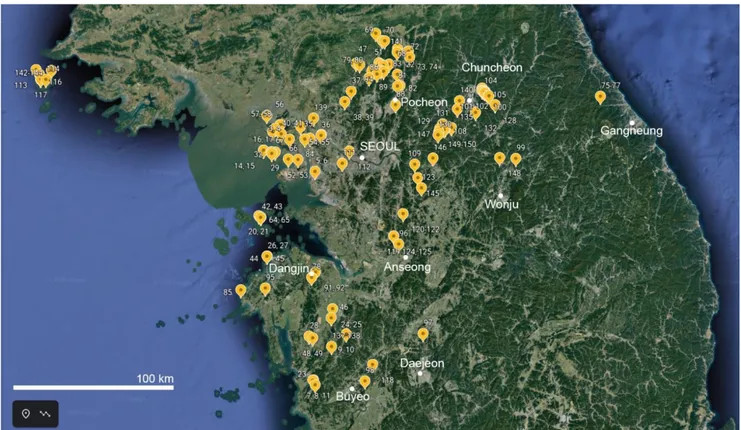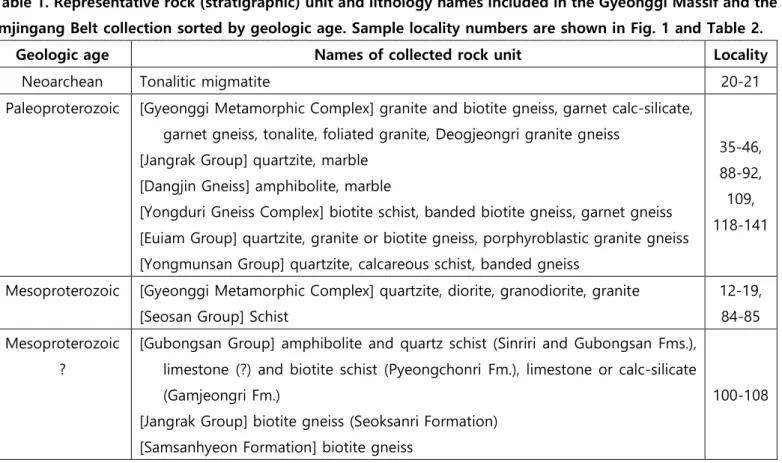[Article]
한국지질자원연구원 지질박물관 보유 실물데이터: 경기육괴 및 임진강대 암석표본
이승배1, 조등룡2, 안기오1, 임지현1
한국지질자원연구원(KIGAM) 지질박물관1, 한국지질자원연구원(KIGAM) 지질연구센터2
Physical data of the Geological Museum, KIGAM: rock sample collection of the Gyeonggi Massif and the Imjingang Belt
Seung-bae Lee1, Deung-Lyong Cho2, Gi O An1, Ji-Hyeon Im1
Geological Museum Korea Institute of Geoscience and Mineral Resources (KIGAM)1, Geological Research Center, Korea Institute of Geoscience and Mineral Resources (KIGAM) 2 (Received: 20 April2020, revised: 19 May 2020, accepted: 20 May 2020)
*Corresponding author: sblee@kigam.re.kr
국문 요약문: 한국지질자원연구원 지질박물관은 광물, 암석, 화석 등 다양한 지질표본을 수집해 오고 있으며, 이 를 전시, 교육, 연구 등에 활용하고 있다. 본 기술 보고에서는 지질박물관이 소장한 암석표본 중 2016년부터 2018년까지 수집한 경기육괴와 임진강대의 암석 표본 컬렉션 150점을 소개한다. 경기육괴 및 임진강대는 한반도 지체구조학적 연구에 있어서 중요한 지역으로 간주되기 때문에, 이 암석 표본들은 최근 밝혀진 지질 및 층서 정 보가 반영된 표준 암석 표본 수집 목적으로 채취되었다. 각각의 암석 표본은 산출 및 보관 위치, 지층 또는 암석 단위 명칭, 지질시대 등의 정보와 함께 목록화 되어있다. 실물데이터로서 암석 표본은 신규/후속 연구의 초석 또 는 과거 연구 결과의 확인과 검증을 위한 자료로서 보존 및 공유될 때 그 가치가 높아지므로 지질과학 교육뿐만 아니라 연구에 있어서 지질박물관 암석 컬렉션의 활용도가 제고되길 기대한다.
국문 주요어: 지질박물관, 암석 표본, 신지질층서, 경기육괴, 임진강대
Abstract: The geological museum of Korea Institute of Geoscience and Mineral Resources (KIGAM) has collected various geological samples such as minerals, rocks, and fossils, and uses them for exhibitions, education, and research. This technical report introduces 150 rock specimens of the Gyeonggi Massif and Imjingang Belt collection, collected from 2016 to 2018, among the rock samples archived by the Geological Museum. Since the Gyeonggi Massif and Imjingang Belt are considered important areas for tectonic research on the Korean Peninsula, these rock specimens were collected in order to archive standard rock samples with updated geologic and chronostratigraphic information. Each rock specimen is listed with geologic information such as sampling and storage location, stratigraphic or rock unit name, and geological age. Rock specimens, as physical data, are valuable when preserved and shared for development of new or follow-up studies and for reinspection or verification of previous research
results. It is expected that these rock specimens will be actively used in geoscientific research as well as education.
Keywords: Geological Museum, Rock sample collection, updated geology and chronostratigraphy, Gyeonggi Massif, Imjingang Belt
1. 서언
1992년 설립된 “지질표본관”을 전신으로 2001년 개관한 한국지질자원연구원(KIGAM) 지질박물관의 주요 업무는 지질표본의 수집과 보존, 그리고 이를 활용한 기초 학술연구 및 전시/교육이다. 크게 광물, 암석, 화석, 복제품으 로 분류되는 지질표본은 종류별 분류 기준에 따라 독립적 코드가 부여되어 있으며 자체 수집, 기증, 구매 등의 방법을 통해 매년 추가되고 있다. 자체 수집의 경우 연구 또는 전시 목적에 제한되거나 지질박물관이 수행하는 연구과제의 내용에 따라 연도 또는 기간별로 주제를 특정하여 수행되기도 한다.
1990년대 후반부터 저어콘 아입자의 U-Pb 동위원소 분석이 활성화되었다. 그에 따라 우리나라에서 화석이 산출 되지 않는 (변성)퇴적암과 복잡한 지열사를 경험한 (변성)화성암의 생성 연령이 비교적 정확히 알려지기 시작하 여, 지층 또는 암체의 지질시대가 규명되고 한반도의 지체구조적 진화에 중요한 의미를 가지는 새로운 암체들이 보고되어 왔다(Choi et al., 2016; Ahn et al., 2019 및 그 안에 인용된 문헌 참조). 최근 20여 년에 걸친 이러한 지 질 및 층서의 변화를 반영한 지질표본을 확보하기 위해 지질박물관은 2016~2018 동안 경기육괴, 임진강대, 옥천 대 등 지역을 대상으로 암석 표본을 채취하였다. 이 기술보고는 교육 및 연구에 공동 활용이 가능한 지질박물관 소장품 중 경기육괴와 임진강대의 암석 실물표본 컬렉션을 우선 소개한다.
Fig. 1. Sample localities marked on the Google Earth map; The locality numbers are also shown in Table 1 and 2.
2. 표본 채취 방법 및 표본의 종류
표본 채취를 위해 기존 논문들과 한국지질자원연구원 연구보고서에서 각 층서 단위를 대표할 수 있으며 절대 연 령이 비교적 확실하게 보고된 암체 위주로 노두 위치를 취합하고, 구글어스, 다음지도 등의 인공위성 및 항공사 진을 검색하여 표본 채취 후보 지점을 사전 선정하고 현지를 방문하여 표본을 채취하였다. 표본 채취 위치 선정 은 조등룡, 현장 채취는 조등룡과 안기오에 의해 주로 수행되었다. 채취 위치는 Fig. 1에 표시하였다.
2016년에는 경기도 김포-연천-파주, 인천광역시 강화군, 옹진군의 장봉리와 이작리, 충남 보령-예산-청양-태안-홍 성 등 경기육괴 서부 및 임진강대 40 여 개 지점에서 67개 표본, 2017년에는 강릉, 김포, 연천-포천, 당진-태안 등 경기육괴 북서부 20 여 개 지점에서 28개 표본, 2018년에는 춘천-가평-홍천-횡성 등 경기육괴 중앙부와 백령 도, 광주-용인-안성, 세종시 부강면-공주-청양 등 지역의 45개 지점에서 55개의 표본이 채취되었다(Fig. 1).
지질박물관 암석 표본은 크게 화성암, 변성암, 퇴적암으로 구분된다. 이는 다시 화성암 74종, 변성암 48종, 퇴적암 43종으로 분류되며, Harrison and Sabine (1970)에 근거한 세부 암종별 코드가 부여된다. 개개의 표본에는 암종 코 드 뒤에 일련번호를 추가한 표본 코드가 부여된다. 각 표본마다 보관/전시 위치, 획득(기증/채취/구매)자, 획득 일 시, 산출지(좌표), 크기, 국문/영문 분류 명칭, 지질시대, 지층명 등의 정보가 추가된다.
경기육괴 및 임진강대 컬렉션을 요약하여 도시하면 Table 1과 같다. 최대한 단순화 하면서도 연구자들에게 관심 의 대상이 되는 지역 또는 암석의 포함 여부를 쉽게 확인할 수 있도록 지층 또는 층서 단위명과 그에 포함된 암 상명을 지질시대별로 정리하였다. 경기육괴 및 임진강대 컬렉션 총 150개 암석 표본에 대한 목록 원본은 첨부파 일(Table 2)을 참조할 수 있다. 이 컬렉션에 대한 암석 코드 부여 및 데이터베이스 입력 과정은 임지현에 의해 수 행되었다.
Table 1. Representative rock (stratigraphic) unit and lithology names included in the Gyeonggi Massif and the Imjingang Belt collection sorted by geologic age. Sample locality numbers are shown in Fig. 1 and Table 2.
Geologic age Names of collected rock unit Locality
Neoarchean Tonalitic migmatite 20-21
Paleoproterozoic [Gyeonggi Metamorphic Complex] granite and biotite gneiss, garnet calc-silicate, garnet gneiss, tonalite, foliated granite, Deogjeongri granite gneiss
[Jangrak Group] quartzite, marble [Dangjin Gneiss] amphibolite, marble
[Yongduri Gneiss Complex] biotite schist, banded biotite gneiss, garnet gneiss [Euiam Group] quartzite, granite or biotite gneiss, porphyroblastic granite gneiss [Yongmunsan Group] quartzite, calcareous schist, banded gneiss
35-46, 88-92, 109, 118-141
Mesoproterozoic [Gyeonggi Metamorphic Complex] quartzite, diorite, granodiorite, granite [Seosan Group] Schist
12-19, 84-85 Mesoproterozoic
?
[Gubongsan Group] amphibolite and quartz schist (Sinriri and Gubongsan Fms.), limestone (?) and biotite schist (Pyeongchonri Fm.), limestone or calc-silicate (Gamjeongri Fm.)
[Jangrak Group] biotite gneiss (Seoksanri Formation) [Samsanhyeon Formation] biotite gneiss
100-108
Neoproterozoic [Gyeonggi Metamorphic Complex] quartzite, marble, amphibolite, granite gneiss [Baekryeong Group] sandstones (Dumujin, Jangchon Fms.), shale, siltstone, and
slate (Junghwadong Fm.)
[Jangbong Schist] marble, quartzite, amphibolite Gamaksan Syenite
22-34, 86-87, 110-117
Paleozoic [Gyeonggi Metamorphic Complex] metadacite [Yeongjong Schist] quartz schist
[Taean Group] chlorite schist
[Yeoncheon Group] marble and schist (Misan Fm.), phyllite (Cheondeoksan Fm.)
47-53, 93-95
Triassic [Yangpyeong Igneous Complex] gabbro
[Songrim Granites] (biotite) granite, diorite, (porphyritic) gabbro, granodiorite
54-67, 145-146 Jurassic [Gimpo Group] sandstone, carbonaceous shale (Jeokseong Fm.)
[Daedong System] sandstone, conglomerate, tuff [Daebo Granites] (biotite) granite, granodiorite
5-11, 75-83,
96-99 Cretaceous Gyeyangsan Tuff, Dongmakgol Tuff, Myeongseongsan Granite, Bojangsan Granite
[Bulguksa Granites] biotite granite, granodiorite
1-4, 68-74
Quaternary Jinchon Basalt 142-144
Unknown [Yongmunsan Group] amphibolite, serpentinite 147-150
3. 결언
지질박물관이 지질표본을 수집 및 관리하는 목적은 1) 지질과학 대중화를 위한 전시 및 교육 기초 자료로 활용, 2) 지질과학 연구에 활용, 3) 지질유산으로서 중요 지질표본의 보존 등 크게 세 가지이다. 이 기술 보고에서 공개 한 표본 중 일부는 이미 전시되어 있다. 한편, 암석, 변성, 층서, 지구조 등 다양한 분야의 지질과학 연구 대상이 되는 암석은 야외에서 수시 접근이 가능하지만은 않다. 산업화 및 국토의 각종 개발로 인해 주요 지질노두가 사 라지는 경우도 빈번히 발생하며, 접근이 용이하지 않은 곳에서 중요한 암석 노두가 발견되어 보고되기도 한다.
따라서 학술적으로 중요한 지질표본들은 신규 연구의 초석 또는 과거 연구 결과의 확인과 검증을 위한 자료로서 보존 및 공유될 때 그 가치가 높으며, 이러한 표본들은 후속 연구 활성화를 유도할 수도 있다.
전시 중인 표본을 포함하여 지질박물관 소장 암석들은 열람 및 대여가 가능하며, 일부 표본의 경우 조건에 따라 분할채취도 가능하다. 이미 연구가 끝난 KIGAM 내외외부의 중요한 암석 표본에 대해서는 기증도 받고 있다. 지질 박물관의 암석 표본들이 전시뿐만 아니라 지질과학 교육과 연구에서도 직접적으로 활용되기를 기대한다.
4. 사사
이 연구는 한국지질자원연구원의 주요사업인 “지질박물관 기초학술 연구 및 전시 콘텐츠 개발(GP2015-008)”과
“지질자원 표본외기초학술연구와 탈추격 R&D 정책개발(GP2017-005)” 연구과제의 지원을 받아 수행되었다. 심사 과정에서 건설적인 의견을 주신 김윤섭 교수, 암석 표본 목록 정리에 도움을 주신 KIGAM 김정찬 박사께 감사드 린다.
5. 참고문헌
Ahn EY, Kim SY, Lee JW, Lee OS, Bae JH, Choi SJ, An GO, Cho DL, Kim JC, Lee SB, Lee HJ, Hong PS, Im JH, Oh IY, Shin YE, Park CS, Hyun HJ, Lee ES, Jeong YH, Yoon DS (2019) Basic Researches in Application and Development of Geological Samples and Geo-Technology R&D Policy (GP2017-005). Korea Institute of Geoscience and Mineral Resources, Daejeon, Republic of Korea, 345 p
Choi SJ, An GO, Im JH, Lee HJ, Oh IY, Shin YE, Kim YB, Cho DL, Hong PS (2016) Basic Researches in Geological Museum and Development of Display Contents (GP2015-008). Korea Institute of Geoscience and Mineral Resources, Daejeon, Republic of Korea, 304 p
Harrison RK, Sabine PA (1970) A petrological-mineralogical code for computer use. Institute of Geological Sciences Report, London, 70(6), 134 p
6. 데이터셋에 대한 메타데이터
구분 필드명 하위카테고리#1 하위카테고리#2 설명 비고
필수
Title 암석 실물데이터
KIGAM 지질박물관 소장 경기육괴-임진강대
암석표본 컬렉션
*DOI name
*Category 암석 표본 Abstract
*Temporal
Coverage 2016년 ~ 2018년
*Spatial Coverage
대한민국
강원도, 경기도, 서울특별시, 세종특별자치시,
인천광역시, 충청남도 등 위도 36.2°N ~
38.2°N, 경도 124.6°E
~ 128.7°E 영역
*Personnel 등록자(임지현)/소유자 (KIGAM)
임지현 지질박물관
jhim@kigam.re.kr
*License 공개 데이터 공개 데이터 공개용 참고 자료
선택 *Project 1. GP2015-008 1. 지질박물관 기초학술 KIGAM
2. GP2017-005 연구 및 전시 콘텐츠 개발 2. 지질자원
표본외기초학술연구와 탈추격 R&D 정책개발
주요사업
*Instrument

